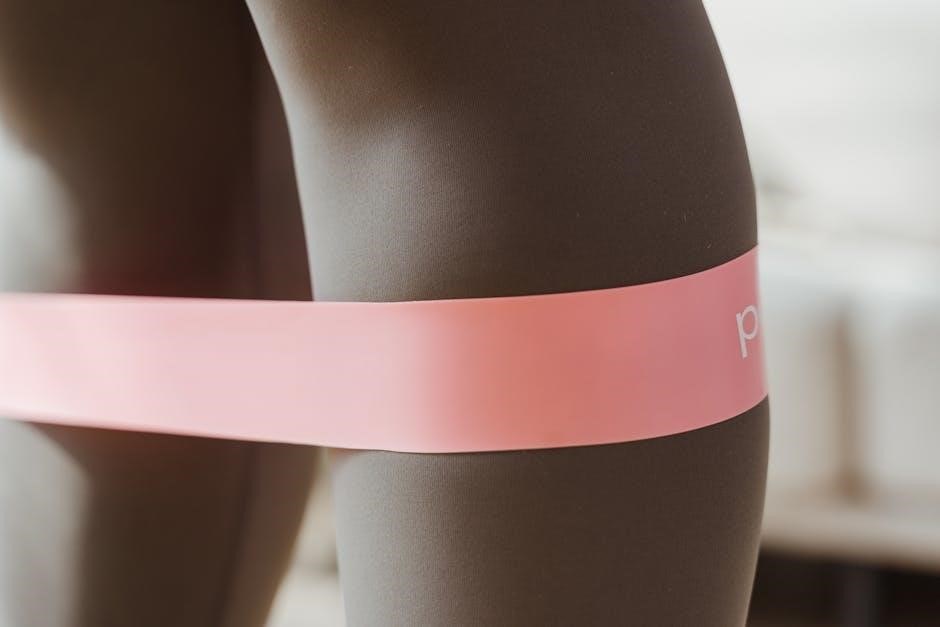Understanding Iliotibial Band Syndrome (ITBS)
ITBS is a common overuse injury causing pain on the outer thigh, knee, and hip due to repetitive friction of the IT band․ The IT band, a thick connective tissue running from the pelvis to the shin, stabilizes the knee during movement․ Overuse, training errors, or skeletal misalignment can lead to irritation and discomfort, especially in runners and cyclists․ Symptoms include sharp pain, swelling, or tenderness along the lateral knee, worsening with activity․
Definition and Overview
Iliotibial Band Syndrome (ITBS) is a common overuse injury characterized by inflammation and irritation of the iliotibial band (IT band), a thick fibrous tendon that runs along the outer thigh from the pelvis to the shinbone․ The IT band plays a crucial role in stabilizing the knee during activities like running, cycling, and walking․ When the band repeatedly rubs against the lateral femoral condyle (a bony prominence near the knee), it can cause friction, leading to pain, swelling, and discomfort on the outer side of the knee․ ITBS is often referred to as “runner’s knee” and is prevalent among athletes and individuals who engage in repetitive knee-bending activities․ Early diagnosis and proper management are essential to prevent long-term discomfort and restore mobility․
Causes and Risk Factors
The primary cause of ITBS is repetitive friction of the IT band against the lateral femoral condyle, leading to inflammation and irritation․ Overuse injuries from activities like running, cycling, or hiking are common triggers․ Training errors, such as sudden increases in mileage or intensity without proper recovery, also contribute․ Anatomical factors, including leg length discrepancies, high arches, or femoral neck anteversion, can predispose individuals to ITBS․ Weakness in the hip abductors and tightness in the tensor fasciae latae muscle are additional risk factors, as they alter running mechanics and increase IT band tension․ Proper training techniques and muscle balance are crucial for prevention․
Symptoms and Diagnosis
The primary symptom of ITBS is sharp, stabbing pain on the outer side of the knee, often worsened by activities like running, cycling, or climbing stairs․ Swelling and tenderness along the IT band may also occur․ Pain typically intensifies when the knee is bent at a 30-degree angle, such as during the mid-swing phase of running․ Diagnosis involves a physical exam, with palpation of the lateral knee to identify tenderness․ Imaging, like X-rays or MRIs, may be used to rule out other conditions․ A thorough medical history and activity assessment are essential to confirm ITBS, as symptoms can overlap with other knee injuries․ Early detection is key for effective treatment and recovery․

Effective Stretches for ITBS Relief
Targeted stretches, such as standing IT band stretches and cross-legged poses, help reduce tension and alleviate pain․ Foam rolling also aids in loosening tight IT band tissue․
Standing IT Band Stretch
Stand a few inches from a wall, positioning your affected hip toward the wall․ Place your hand on the wall for balance․ Bend your knee slightly and let your affected hip drop outward until you feel a stretch along the outer thigh․ Hold for 30 seconds, then switch sides․ This stretch targets the IT band, reducing tension and discomfort․ It’s essential to maintain proper form to avoid strain․ Perform 2-3 sets daily for optimal relief․ Regular practice helps improve flexibility and prevent ITBS recurrence, especially for runners and cyclists prone to this condition․
Cross-Legged IT Band Stretch
Sit on the floor with your legs crossed, placing the affected leg behind the unaffected one․ Lean your torso forward slightly until you feel a stretch along the outer thigh of the affected leg․ Hold for 30 seconds and repeat 2-3 times․ This stretch targets the IT band, helping to reduce tightness and alleviate pain․ It’s a simple yet effective method to improve flexibility and relieve ITBS symptoms․ Regular practice can prevent recurrence and enhance overall hip and knee mobility, making it ideal for runners and cyclists․ For maximum benefit, combine this stretch with other IT band exercises and maintain consistent practice․
Foam Rolling Techniques
Foam Rolling Techniques
Lie on your side with the foam roller placed under the affected leg, just below the hip joint․ Support your body weight with your hands and the opposite leg, which is crossed in front for balance․ Slowly roll back and forth from just below the hip to the top of the knee, focusing on the outer thigh where the IT band is located․ This technique helps reduce tightness and inflammation in the IT band․ While it may feel uncomfortable initially, consistent foam rolling can significantly alleviate ITBS symptoms․ Regular use improves circulation and breaks down adhesions, promoting long-term recovery and preventing recurrence․

Additional Rehabilitation Exercises
Strengthening hip and core muscles enhances stability and reduces ITBS recurrence․ Tailored routines, including balance exercises and hip-specific workouts, promote long-term recovery and prevent future injuries effectively․
Strengthening Exercises for the Hip and Knee
Strengthening the hip and knee muscles is essential for ITBS recovery and prevention․ Exercises like clamshells, side-lying leg lifts, and glute bridges target the gluteus medius and hip abductors, improving stability․ Straight-leg raises strengthen the quadriceps without stressing the knee․ Incorporating functional exercises, such as step-ups and balance training, enhances joint stability and reduces injury risk․ Strengthening these areas helps alleviate IT band tension and promotes proper biomechanics during activities like running or cycling․ Consistent practice of these exercises can significantly reduce the likelihood of ITBS recurrence and improve overall lower limb function․
Flexibility and Mobility Routines
Improving flexibility and mobility is crucial for managing ITBS․ Regular stretching of the IT band, hamstrings, and hip flexors helps reduce tension and promotes joint mobility․ Techniques like standing IT band stretches, cross-legged stretches, and foam rolling are effective for loosening tight tissues․ Dynamic stretches, such as leg swings and lunges, can enhance range of motion and prevent stiffness․ Incorporating yoga or Pilates can also improve flexibility and overall lower limb alignment․ Consistent mobility work reduces the risk of IT band irritation and supports long-term recovery․ These routines should be performed gently and held for extended periods to maximize benefits and maintain muscle elasticity․

Prevention and Long-Term Management
Preventing ITBS involves consistent stretching, proper training techniques, and equipment․ Regular IT band stretches, foam rolling, and maintaining hip strength reduce recurrence․ Gradual training increases and avoiding overuse are essential for long-term management, promoting sustained recovery and minimizing symptoms․
Training Tips to Avoid ITBS
To prevent ITBS, incorporate gradual training intensity increases, allowing time for recovery․ Avoid repetitive downhill running or cycling, as it exacerbates IT band friction․ Include rest days and cross-training to reduce overuse․ Proper footwear and orthotics can correct biomechanical issues․ Strengthen hip and glute muscles to improve running mechanics․ Avoid excessive hill repeats and sudden changes in mileage or intensity․ Incorporate IT band stretches and foam rolling post-workout to maintain flexibility․ Ensure proper bike fit for cyclists to minimize knee strain․ By balancing strength, flexibility, and recovery, athletes can significantly reduce the risk of developing ITBS and maintain long-term performance without injury․
Proper Equipment and Biomechanics
Using the correct equipment and maintaining proper biomechanics are essential to prevent ITBS․ Wear properly fitted shoes with adequate support and cushioning, and consider orthotics if you have biomechanical imbalances․ For cyclists, ensure your bike is fitted correctly to avoid excessive knee strain․ When running, focus on a midfoot strike and avoid overpronation or supination․ Strengthening the hips and glutes can improve running mechanics and reduce IT band stress․ Avoid training in worn-out shoes, as they can lead to poor alignment․ Regularly check your equipment for wear and tear․ Proper biomechanics, such as maintaining a slight knee bend during activities, can significantly reduce the risk of ITBS development․
Maintenance Stretches for Ongoing Care
Regular stretching is crucial for managing ITBS and preventing recurrence․ Start with a standing IT band stretch: stand near a wall, cross the affected leg behind the other, and lean toward the unaffected side until a stretch is felt․ Hold for 20-30 seconds and repeat 2-3 times․ The cross-legged stretch is another effective option: sit with the affected leg crossed behind the other, then lean forward slightly to stretch the outer thigh․ Foam rolling the IT band daily can also reduce tension․ Incorporate these stretches into your daily routine, especially after workouts․ Consistency is key to maintaining flexibility and preventing ITBS flare-ups․ Always combine stretching with proper warm-up and cool-down routines for optimal results;

